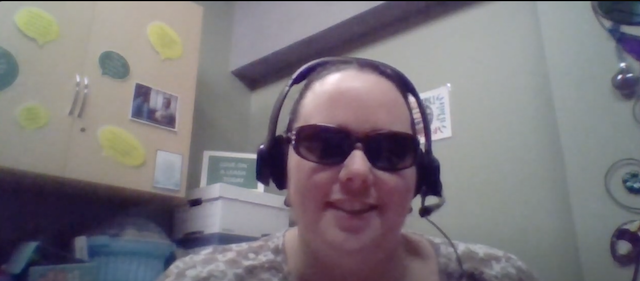Katie Lester Was on the Digication Scholars Conversations
Have a look at the life of a visually impaired student navigating the complexities of higher education in a world that struggles to understand the challenges and accommodate the needs of those with disabilities.
In this outstanding episode, we share the heartening journey of Katie Lester, a visually impaired student pursuing a degree in social work at the University of Alaska Anchorage. She reveals how ePortfolios have significantly supported her journey and how she has used her experience to educate others.
She hopes the visually impaired get the support they deserve as they tell their story using web-based technology platforms.
The Digication team will forever be grateful for Katie. We appreciate her unique perspective, dedication to helping others, and the time she invested in our work together. Our partnership improved our platform and approach to creating accessible technology. Advancements that go beyond accessibility requirements while providing delightful user experiences for individuals with visual impairments.
Overcoming Learning Limitations With Accessible ePortfolios

Katie’s vision impairment became evident in her thirties when she started losing her vision. She admitted that it was a very trying period, especially “when you’ve had sight for thirty years, and then you don’t have it,” but she never allowed it to determine her learning capabilities.
Pursuing her passion with unwavering courage, Katie said it was an awakening to her current reality. She talks about embracing her challenges head-on, relying on modern technology like speech recognition, color contrast codes, and accessible labels while using the ePortfolio. In the company of her specially-trained seeing-eye dog, these tools have enabled Katie to break barriers and pave her way toward academic success.
According to her, having practical and easy-to-use tools “feels like independence.” She talks about the need to be able to do things independently, including surfing web pages and creating and managing an ePortfolio.
Going blind as an adult and training to adjust to this new reality was challenging. However, Katie’s determination to never give up allowed her to shine bright and become one of the thirty scholarship recipients at the National Federation of the Blind Scholarship Program. Her scholarship was for academic excellence and service to the community.
How Is An ePortfolio Useful To The Visually Impaired?
The ePortfolio presented a lifeline for Katie’s ambitions. The learning, reflection, and assessment tool plays a vital role in how blind students perceive and tell their story. This piece of technology comes in handy for collecting, keeping, and showcasing academic track records. It’s, nonetheless, a prominent learning tool in gen ed, project-based, active and experiential learning.
It’s rather underwhelming for educational technology tools to not be inclusive for both the abled and disabled. Leveraging headings, labels, and lists to scan pages, Katie could easily navigate through different pages of the Digication ePortfolio with the help of a screen reader. The reflective capabilities and ability to conveniently store and assess her work proved to be a complementing tool that grants her accessibility to ease her studies.
-
For Promoting Accessibility for Empowerment
Accessibility features on Digication opened up a new chapter of possibilities for our visually-impaired guest. She emphasized the importance of making websites usable for people with disabilities. Katie, a blind student, demonstrated how she seamlessly navigates through her ePortfolio pages while using digital assistants.
Equipped with screen readers and voice-over functionalities, the platform enabled her to navigate course materials, assignments, and feedback effortlessly.
Over the years, we’ve had several collaborations between Katie, Jeff, and Paul Wasco from the University of Alaska Anchorage to improve accessibility in ePortfolios and other technology, benefiting both visually impaired and non-impaired users.
Katie implores advocates and technology providers to focus on accessibility to create a more inclusive digital environment for equal access to education, particularly for students with disabilities. -
To Aid Active and Reflective Learning
As a social work student, Katie’s coursework often included field experiences, reflective writing, and other presentations. Katie could use different file formats, such as audio recordings and text-to-speech conversations, with the help of an accessible ePortfolio. So good her creativity can be easily showcased, as well as her skills and insights.
Katie could document her personal growth, challenges, and achievements as she navigates her academic journey, she highlighted the importance of making websites usable for people with disabilities.
Using the Accessible Rich Internet Applications (ARIA) technical specifications, items with ARIA labels, such as buttons, forms, search widgets, or links, can be more descriptive. This will, in turn, enhance the ease with which people with disabilities interact with the different elements in the learning tool. -
To Build a Professional Identity
By routinely updating her ePortfolio, Katie could visualize her progress and build on her learning experiences, creating a rich archive of her educational and professional development.
As she delved deeper into her social work program, she fuels her passion through the outstanding outcomes she’s managed, and plans to pursue a master’s degree in social work. More so, she intends to work with individuals who have lost their sight or have disabilities.
Using the ePortfolio platform, she highlights her advocacy work, volunteer experiences, and research projects, all while incorporating her unique perspective as a visually impaired individual.
Katie’s ePortfolio reflects her passion and dedication to social work, and it is a digital showcase of her charismatic personality, skills, and achievements to potential employers, investors, or mentors.
In conclusion, Katie’s resilience and journey are a worthy model. They serve as a beacon of hope for fellow visually impaired learners, encouraging them to embrace their aspirations and pursue higher education despite any perceived barriers.
Through her unwavering spirit, Katie has conquered the challenges posed by her vision impairment, proving that with the right tools, barriers can be broken, and dreams can be achieved.
As we celebrate Katie’s journey, let us remember the importance of creating inclusive environments that empower everyone to shine and contribute their unique perspectives to society.
Katie’s resonant voice reminds us that empowerment has no limitations, and when provided with the right support, people can significantly impact the world around them.
